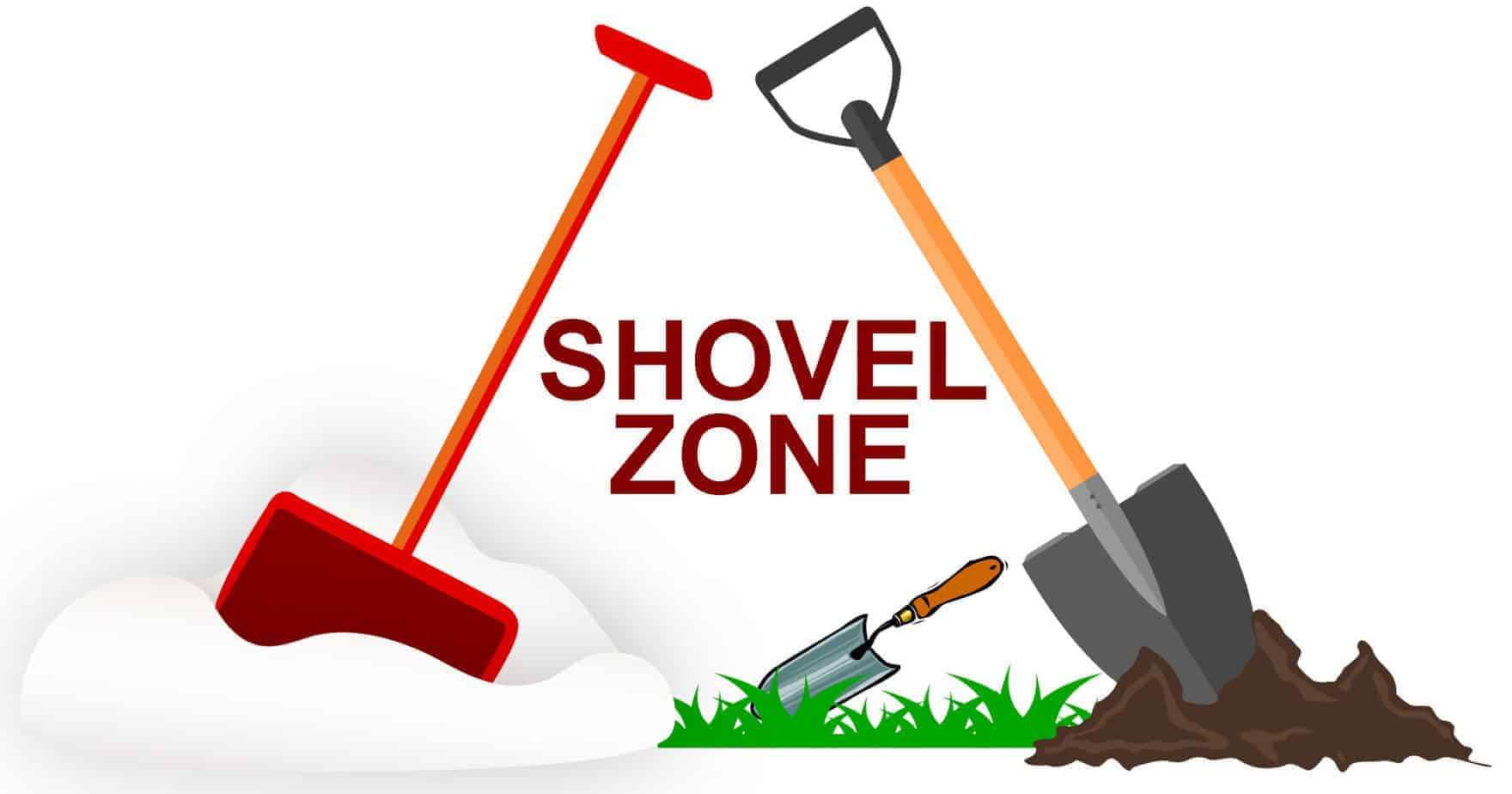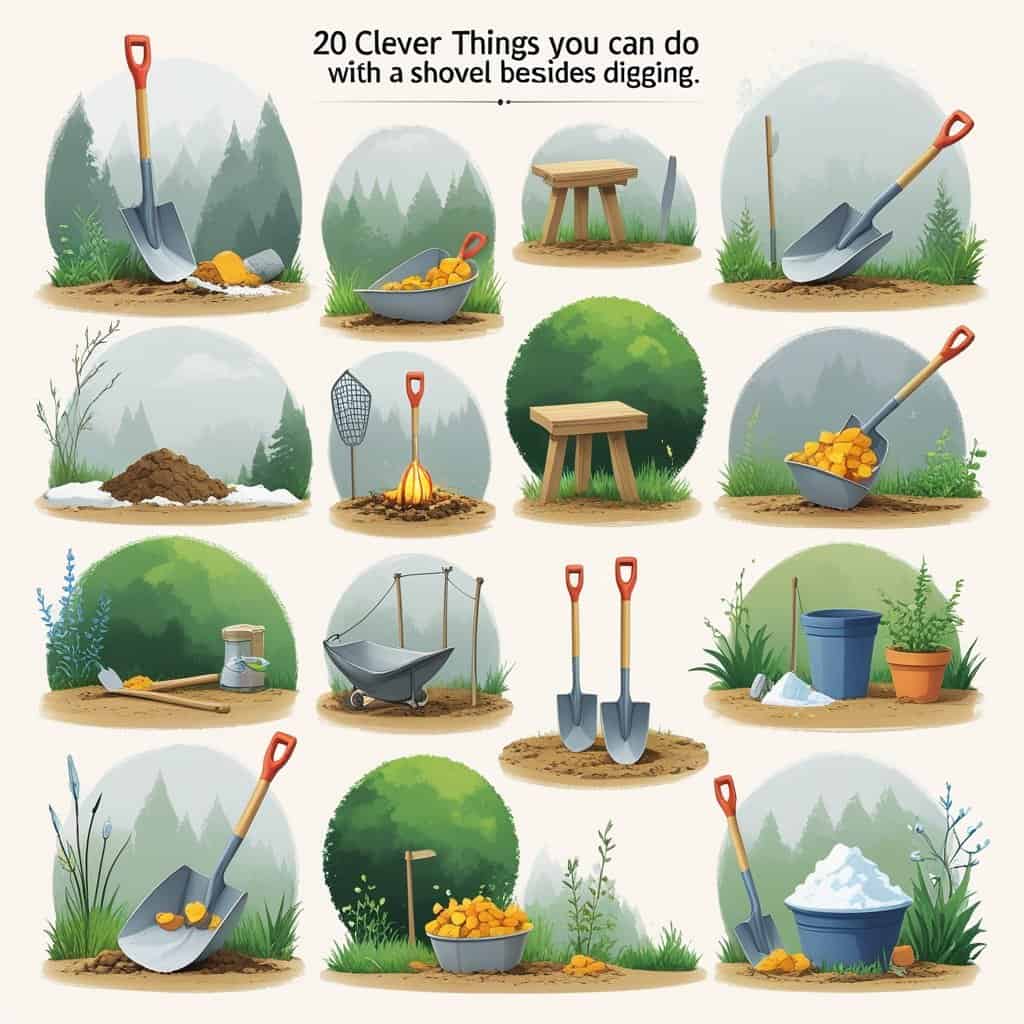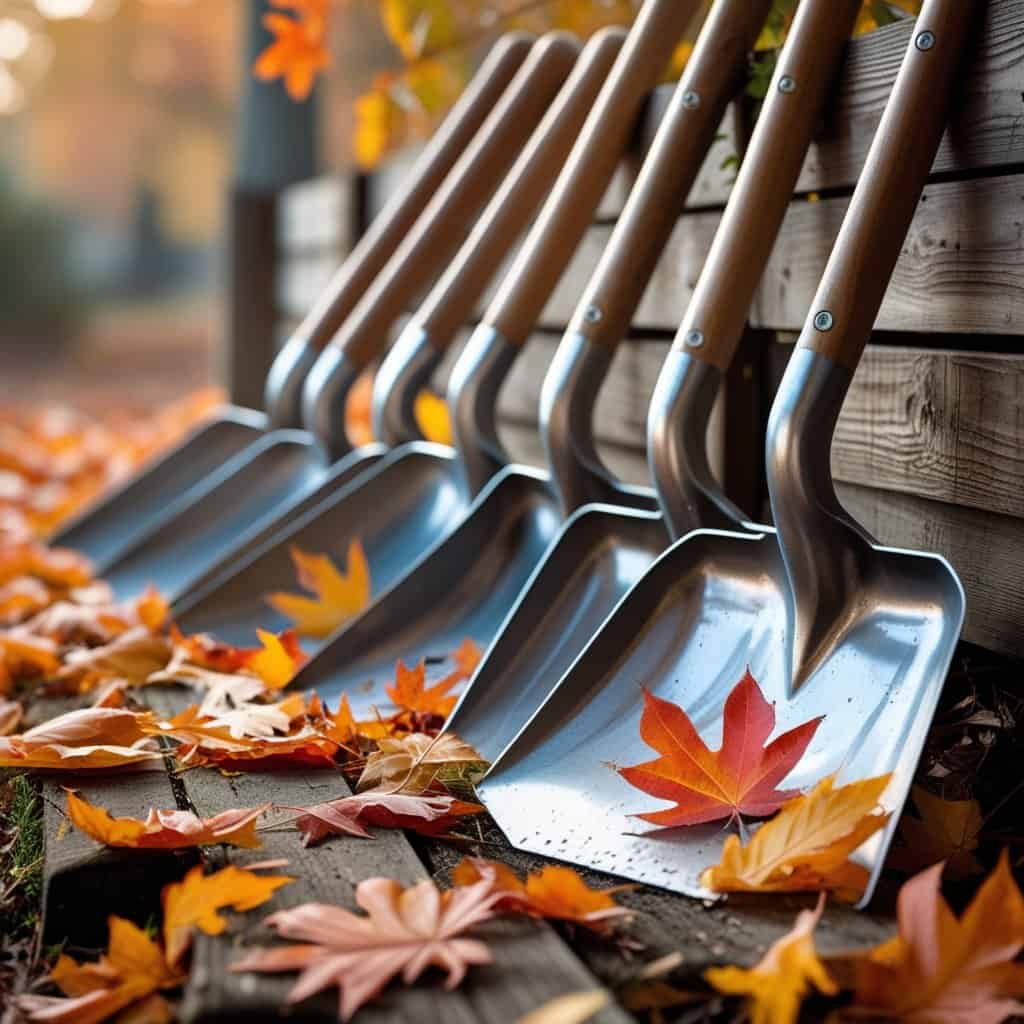A day at the beach feels incomplete without digging in the sand and shaping it into something fun. Whether it’s a simple moat or a detailed castle, the right tools make the process easier and more enjoyable.
Using a shovel to dig in the sand enhances the experience.
A good shovel is essential for effective sandcastle building.
The best shovels for beach trips give us the strength, size, and comfort needed to dig deeper, build faster, and create sturdier sandcastles.
Investing in a quality shovel can save time and effort.
Each shovel has its unique purpose in creating sand structures.
Choosing the right shovel can enhance your overall beach experience.
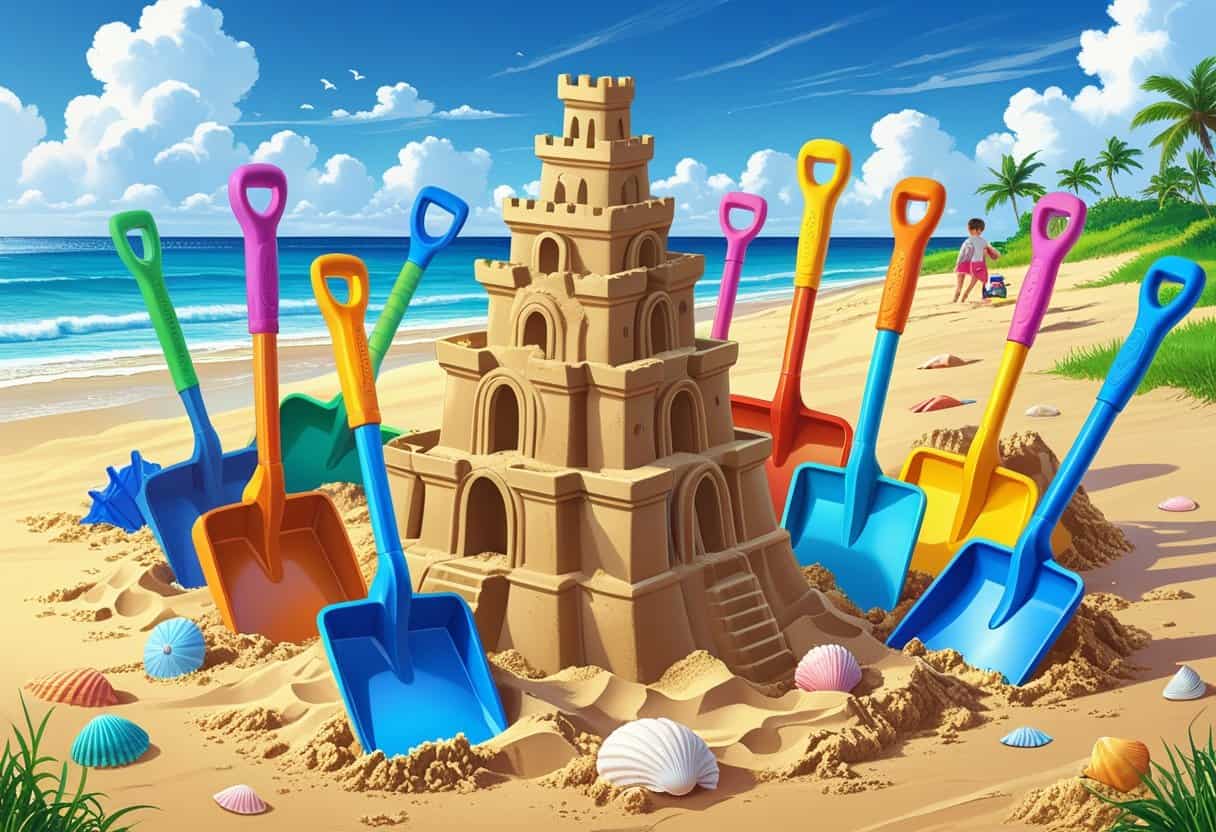
We often think any plastic scoop will do, but not all shovels are equal. Some break too quickly, while others are too small to move enough sand.
By choosing durable, well-sized shovels, we set ourselves up for hours of creative play and less frustration. This makes a big difference when we want to build structures that actually last.
Long-handled shovels are perfect for deeper digging.
In this guide, we’ll look at how to pick the right shovel. We’ll explore sets that include buckets and molds, and share techniques that help us dig smarter.
When building, the right shovel can make all the difference.
We’ll also cover how these tools support sensory play, how to take care of them, and answer common questions so we can enjoy every beach trip to the fullest.
Table of Contents
Choosing the Right Beach Shovel
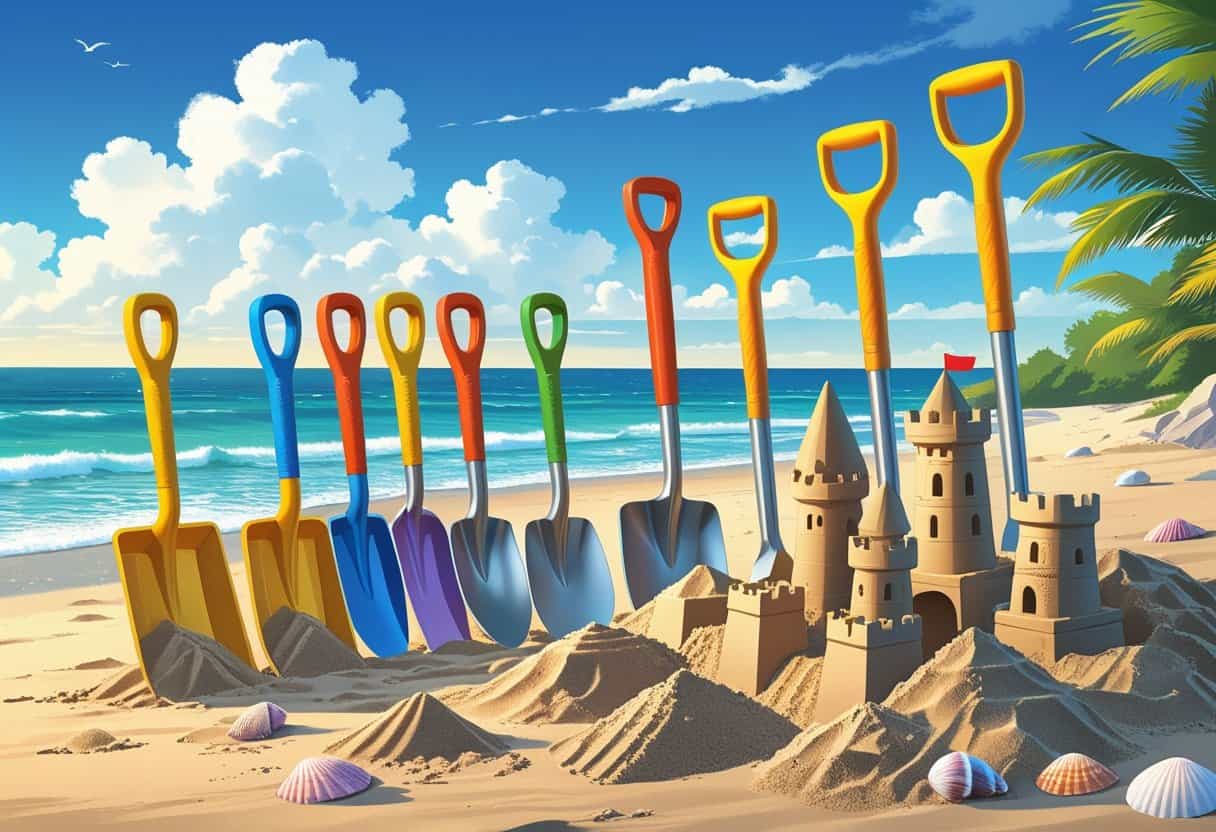
The ideal shovel should cater to both adults and children.
We need a beach shovel that is sturdy enough for digging, sized correctly for the user, and designed to handle sand without breaking. The right choice depends on whether we want quick digging, detailed shaping, or a balance of both.
Types of Shovels for the Beach
Beach shovels come in several forms, and each works best for different tasks. Long-handled shovels help us dig deeper holes without bending too much, making them useful for moats or larger sand structures.
Short-handled shovels are better for kids and for shaping details in sandcastles. Some sets, like the Greeily Beach Shovel Long Handle, come in packs with multiple sizes.
This gives families flexibility, since children can use smaller shovels while adults handle the heavier digging. We also see collapsible shovels, often used for camping, that fold down for easy storage.
While not designed only for sand, they can be practical for travel when space is limited. For group play, multi-piece kits with shovels, buckets, and molds provide everything needed for castle building and creative play.
Essential Features for Sandcastle Building
A strong beach shovel should balance comfort, durability, and efficiency. Handle length matters because it affects posture and control.
Long handles reduce strain for adults, while short handles give children better grip and control. Blade shape is also important.
A flat blade smooths walls and levels surfaces, while a pointed blade cuts into sand for deeper digging. Choosing the right blade helps us work faster and with more precision.
We should also check the grip material. Rubber or soft plastic grips reduce slipping, especially when our hands are wet.
Weight is another factor—lighter shovels are easier for kids, while slightly heavier ones often last longer. When buying a set, we should look for screw reinforcement or strong joints that keep the blade from loosening.
Features like easy-to-clean surfaces and compact storage also make a shovel more practical for repeated use.
Plastic vs. Metal Sand Shovels
Plastic sand shovels are lightweight, affordable, and safe for children. They usually come in bright colors and fun shapes, making them appealing for play.
However, they can snap if used on packed sand or rocky areas. Metal shovels, often made with stainless steel or carbon steel, are much stronger.
They handle tougher digging and last longer, though they can feel heavier and may get hot in the sun. Some models combine a metal blade with a wooden handle, giving us durability and comfort in one tool.
For family trips, plastic shovels work well for younger kids, while adults benefit from sturdier metal designs. In some cases, mixed sets that include both types offer the best balance between fun and function.
If we want a shovel that can handle both sand and occasional snow play, durable options like the LoayBhok Beach Shovel Toys provide versatility without being too heavy for children.
Must-Have Beach Toys and Sets
When we pack for a beach trip, certain toys make the experience more enjoyable and practical. The right sets help kids build sandcastles, dig moats, and carry water, while also keeping everything organized and easy to transport.
Beach Buckets and Shovel Combos
A sturdy beach bucket paired with a shovel is one of the most useful tools for sand play. Buckets make it easy to haul water from the shoreline, collect shells, or carry sand for building.
Shovels allow kids to dig holes, shape walls, and create details in their sandcastles. Some sets, like the sand buckets with shovels, offer lightweight designs that are easy for children to carry.
We should look for buckets with strong handles that won’t snap under weight. Brands such as Hape offer reliable options.
The Hape Beach Basics Sand Toy Set includes a bucket, shovel, rake, and sifter. This type of combo keeps tools simple but versatile, giving kids what they need without extra clutter.
Durability matters, especially since thin plastic can crack after just a few uses. Choosing thicker plastic or collapsible buckets ensures longer use across multiple beach trips.
Top-Rated Sand Toy Sets
Beyond a single bucket and shovel, full sets provide more creative opportunities. Many include molds, sifters, and extra tools for shaping sand.
These sets encourage kids to build more detailed sandcastles and explore different designs. The 4E’s Novelty 17 Pcs Beach Toys kit comes with collapsible buckets, shovels, and animal molds.
The collapsible design makes it easier to pack in a beach bag or suitcase. Another option is the Joyfy 4 Pcs Beach Shovels Set, available at Target.
This set focuses on sturdy shovels, which are often the most-used tool at the beach. When we choose a set, it helps to think about age.
Younger kids may prefer animal molds, while older kids enjoy larger shovels and tools for digging deeper holes.
Benefits of Complete Beach Toy Kits
Complete kits save time and reduce the need to buy items separately. They often include everything from buckets and shovels to unique molds and sifters, making them practical for families with multiple children.
These kits are also versatile. Many can be used in sandboxes, backyards, or even snow.
The best beach toy sets often include storage bags, which keep everything together and prevent losing small pieces. We also benefit from the variety.
A single kit allows kids to switch between digging, pouring, and shaping without needing extra tools. This variety keeps them engaged for longer periods of play.
Durability, portability, and value are the main advantages. A well-made kit can last for years, making it a smart investment for families who visit the beach often.
Expert Techniques for Digging and Sandcastle Construction
We get better results when we focus on the base, the details, and the overall shape of the sandcastle. Using the right beach shovel, steady water control, and careful carving tools helps us make sand structures that stand firm and look sharp.
Building Strong Foundations
A strong sandcastle starts with the right sand-to-water mix. Wet sand holds better, so we should dig a small water hole near our building spot and use the damp sand from the bottom.
The texture should feel like cake batter—moist but not runny. When forming the base, we need to keep it wide and stable.
A good foundation is about 2 feet across, giving enough support for towers and walls. Using a long-handled beach shovel makes it easier to move larger amounts of sand quickly.
We can stack handfuls of wet sand, letting gravity settle the layers instead of pressing too hard. This prevents cracks and keeps the structure from collapsing.
A solid base makes it easier to add height and detail later without losing stability.
Carving Details Like a Pro
Once the foundation is secure, we shift to shaping and carving. Tools like a small plastic knife, paintbrush, or even a melon baller help create clean lines and textures.
According to sandcastle building guides, brushing away loose grains adds definition and keeps edges sharp. We should always carve from the top down.
This avoids knocking sand onto finished sections below. For towers, trimming the sides with a trowel creates smoother walls.
For windows or arches, a thin stick or straw works well to hollow out shapes without breaking the structure. Light strokes matter more than force.
If we press too hard, we risk breaking off chunks. Gentle carving and brushing allow us to keep the design neat and controlled.
Creative Sandcastle Designs
Designing a sandcastle is easier when we plan before we dig. Sketching a simple outline in the sand helps us place towers, walls, and courtyards in the right spots.
Children enjoy using a shovel to enhance their play experience.
Every child should have a shovel to enjoy sensory play at the beach.
Many experienced builders recommend starting with towers first, then connecting them with walls. We can use the hand stacking method to create tall towers by layering wet sand patties.
Each layer should be slightly smaller than the one below it, giving the tower height without making it too wide. This method is explained in step-by-step sandcastle tips.
Adding creative details like stairs, bridges, or patterned walls makes the castle look more unique. Even simple touches, such as brushing texture onto walls or shaping small battlements, give the design more character.
With the right shovel and tools, we can turn basic shapes into a castle that feels complete.
Sensory Play and Developmental Benefits
Sand shovels do more than help us dig holes or build castles. They support skill-building through sensory play, giving children hands-on experiences that strengthen movement, coordination, and problem-solving.
Encouraging Motor Skills with Sand Shovels
When children use a plastic sand shovel, they practice grasping, lifting, and scooping. These actions strengthen hand and finger muscles, which are important for tasks like writing and drawing later on.
Using a shovel can create memorable beach activities.
Shoveling also supports hand-eye coordination. As kids scoop sand into a bucket, they learn to control movement with purpose.
Repeated motions like digging or patting sand down help refine both gross and fine motor skills. We can also guide children to try different motions with shovels:
A shovel is a must-have for any beach toy kit.
- Digging trenches for water flow
- Scooping and pouring into molds
- Packing sand to build stable structures
Taking care of your shovel extends its lifespan significantly.
These activities encourage problem-solving and persistence. Research shows sand play supports fine motor development and coordination, making shovels a simple but effective tool for growth.
Sensory Play Activities at the Beach
Sand shovels make sensory play more engaging by adding variety to how children touch and explore sand. The texture shifts from dry and grainy to wet and moldable.
Using a shovel helps kids experiment with these changes safely and easily. We can set up activities like a sand treasure hunt, hiding shells or small toys for kids to uncover.
This combines tactile exploration with problem-solving. Another option is creating a construction zone with toy trucks and shovels.
Children can dig tunnels, build roads, and move sand around. This supports imagination and cooperative play.
Care and Maintenance of Beach Shovels and Toys
Using the right shovel ensures safe play for kids.

Keeping beach shovels and toys in good condition helps them last longer and makes every trip easier. Simple cleaning, proper storage, and safe use prevent damage and reduce the chance of accidents.
Cleaning and Storing Beach Gear
We should rinse all beach shovels and toys with fresh water after each use. Sand and salt can wear down plastic, metal, and wood if left unwashed.
A quick rinse at a beach shower or with a water bottle works well. Drying is just as important.
Leaving wet gear in a bag can cause rust on metal parts and mildew on wooden handles. We can lay the items in the sun for a short time or wipe them with a towel before packing.
For storage, lightweight mesh bags help keep sand from collecting. At home, we should store gear in a dry spot such as a garage shelf or outdoor bin.
Keeping them out of direct sunlight prevents plastic from becoming brittle. Labeling sets of toys for kids also makes it easier to track everything.
This way, we avoid losing pieces and can reuse the same set for multiple beach trips.
Safety Tips for Kids and Adults
We need to choose the right shovel size for each user. A small plastic shovel works best for toddlers, while older kids and adults can handle longer handles and sturdier blades.
Oversized tools can strain wrists or cause accidents. Shovels should have smooth edges and secure grips.
A handle with rubber or textured plastic helps prevent slipping. For kids, bright colors make toys easier to spot in the sand, reducing the chance of tripping.
We should also set simple rules. Kids should avoid digging holes deeper than knee height, since large pits can collapse.
Adults can supervise when children build sandcastles or dig tunnels. Carrying shovels carefully matters too.
We should always point the blade down and avoid swinging them near others. These habits keep beach play safe and fun for everyone.
Frequently Asked Questions
We often get asked about the best shovel materials, the right size for different users, and how to keep tools in good condition. We also discuss safe options for kids, efficient digging methods, and shovels that can work beyond the beach.
What are the best materials for durable beach shovels?
We find that metal blades with wooden or reinforced handles last the longest. Stainless steel or high-carbon steel resists bending and breaking, though it can get hot in the sun.
Plastic is lightweight and safe for kids, but it may crack under heavy digging.
How do I choose the right size shovel for building sandcastles?
We recommend shovels with shorter handles for kids and longer handles for adults to reduce strain. A small blade is better for detail work like shaping walls, while a wider blade helps move large amounts of sand quickly.
Can you recommend techniques for efficient sand digging and sculpting?
We suggest starting with a pointed blade to dig deep holes or trenches, then switching to a flat blade for smoothing and shaping. Packing wet sand firmly before carving helps structures hold their shape, as explained in sandcastle building guides.
What features should I look for in a child-friendly beach shovel?
We look for lightweight shovels with rounded edges to keep play safe. Handles with soft grips make it easier for small hands to hold.
Sets like the Greeily Beach Shovel Long Handle are designed for kids and use sturdy yet safe materials.
How do I maintain and clean my beach shovel after use?
We rinse shovels with fresh water to remove sand and salt. Drying them before storage prevents rust on metal parts.
For plastic shovels, a quick wash and air drying are usually enough.
Are there any multi-purpose shovels suitable for both beach trips and gardening?
Yes, some folding or compact shovels work well in both settings.
For example, the PLACHIDAY Digging Shovel can handle sand at the beach and light garden tasks.
Its steel blade and portable design make it useful for camping, hiking, and backyard projects.
